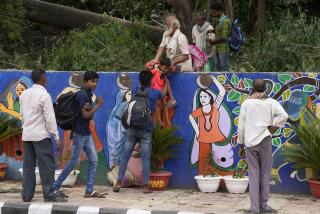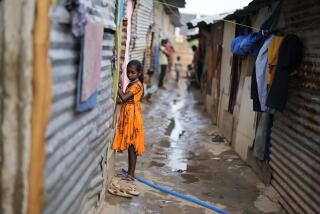In India, Bengalis seek to recapture their glory as intellectuals
- Share via
KOLKATA, India — The dusty files, manual typewriter, aging books and film reels in metal tins languish in Satyajit Ray’s study, largely the way the filmmaker left them on his death two decades ago.
Among the most creative Bengalis of modern times, Ray directed 37 films and wrote 75 short stories when he wasn’t publishing, illustrating, composing and writing critiques. A few weeks before his death, the Academy of Motion Picture Arts and Sciences paid tribute to his life with an honorary Oscar.
People from Bengal — now divided between India’s West Bengal state and Bangladesh — have long enjoyed a reputation as India’s intellectuals, its creative spirits. Many cite an early 20th century quote by Indian freedom fighter Gopal Krishna Gokhale: “What Bengal thinks today, India thinks tomorrow.”
But the creative juices slowed to a trickle in the last few decades as political and economic stagnation fueled a brain drain and older generations died out, epitomized by Ray’s fading, museum-like study.
The state government recently has sought to recapture its cultural glory. Chief Minister Mamata Banerjee declared that within a few years, the state capital, Kolkata (formerly, and unofficially still, known as Calcutta), will not only become India’s cultural capital, but also the world’s.
She named herself cultural affairs head, expanded arts budgets, honors and prizes, named subway stations after cultural icons and promised new auditoriums, archives, research centers and schools.
That’s left some artists questioning whether bureaucrats can lead the renaissance. In fact, many point to the government as a factor in the closing of minds in West Bengal, arguing that last year’s end of the Communist Party’s 34-year reign in the state left a legacy of bureaucratic complacency.
“It’s good they’re gung-ho,” said Qaushiq Mukherjee, 38, a filmmaker. “But I don’t see this resonating from the state.”
Bengalis’ intellectual reputation dates to the 19th century, when Calcutta was the capital of British India. Living directly under the “imperialists” allowed Bengalis to pick up English quickly, exposing them to global ideas, innovation, arts and politics. Soon, Calcutta boasted India’s first trams, gramophones, museum, telephone exchange, modern university.
But it also left many chafing under a foreign power.
“This was the seat of colonial power with lots of repression,” said Partha Pratim Ray, a physics professor at Kolkata’s Jadavpur University. “We Bengalis weren’t strong physically, so we became stronger in our brains to get around them.”
Bengalis were pioneers in outlawing sati, under which Indian widows committed suicide on their husband’s funeral pyres, and in the anti-British nationalism leading to independence in 1947, producing over the years an impressive array of writers, artists, philosophers and social reformers.
These included poet and Nobel laureate Rabindranath Tagore, India’s Tolstoy; nationalist revolutionary Subhas Chandra Bose; and Swami Vivekananda, who introduced Hindu thought to the West, helping to spread and popularize yoga.
In 1911, however, Britain shifted the capital to New Delhi, which gradually diminished Calcutta’s publishing, arts and industrial production.
“The Bengalis thought they were on the vanguard,” said Ramachandra Guha, a historian. “This idea never left them, even as other parts of India eclipsed them.”
This nostalgia is epitomized in a 2005 Hindustan Times column envisioning an India still ruled from Kolkata: “We would be a nation of intellect and not a nation that is largely governed by idiots,” it said. “If there is anything that Calcutta has in abundance, it is soul.”
Echoes of that faded soul are still found in legions of bookstalls around Kolkata’s Presidency University, where S.K. Mansur Ali, 51, sits crouched in a tiny kiosk selling books varying from Stephen King thrillers to the “Manual of Geriatric Psychiatry.”
“Business is bad,” Ali said, blaming computers, changing values and Kolkata’s decline. “I used to be so busy, I couldn’t even talk. Now I have all day. Consumerism is corrupting our minds.”
A few blocks away, up a flight of grungy steps, the ghosts of conversations past echo in the College Street Coffee House, which traces its roots to the 1800s. Once a nexus for scholars, artists and student revolutionaries debating political “isms” over cheap cigarettes, it’s now a hangout for low-end clerks and the unemployed drawn to its cheap chow mein and surly service.
Another blow to their beloved Kolkata, Bengalis say, was the Communists’ three-decade political domination. Although the Left Front initially introduced land reform, it soon settled into inertia and political intrigue, critics say, as anti-business policies and onerous labor rules sparked crippling strikes, driving many corporations away.
“There’s been no job creation and tremendous brain drain,” said Ray, the professor. “It’s not a conducive intellectual atmosphere, and there isn’t good infrastructure.”
Pritish Nandy, a poet, painter, journalist and former lawmaker, was one such refugee. He left Calcutta as a young man to run the then-fledgling Times of India, now the nation’s largest English-language newspaper, in Mumbai. “I felt the opportunity was slipping out,” he said.
Still, Bengalis have clung defensively to their intellectual reputation, some believe, even as vitality has slipped away.
“It’s a belief in the lost cause,” said Swapan Dasgupta, a senior Bengali journalist now living in Delhi. “It’s a lost generation.”
But Kolkata’s loss was India’s — and the world’s — gain, as a host of Bengalis and their offspring populated Indian media, Bollywood and beyond, including Nobel Prize laureate and Harvard economics professor Amartya Sen, filmmaker Aparna Sen, author Amitav Ghosh, Pulitzer Prize-winning writer Jhumpa Lahiri.
For some, Kolkata’s finest don’t necessarily embody creativity. Rather, they’re pretty good at convincing others of their brilliance. “It may look like they’re doing a lot of thinking, but it’s more their articulation,” said Sen, the economist.
In a world obsessed with greed, upward mobility and glitzy shopping malls, some welcome a place where the ideals of faded glory still hold sway.
Back in the elegant, dated apartment of filmmaker Satyajit Ray, his son expresses cautious optimism about Kolkata’s future, even if it never lives up to state leader Banerjee’s boast of becoming the “next London.”
“Changes are happening, although it’s still a bit on the slow side,” said Sandip Ray, 57, also a filmmaker. “We have to be a little more aggressive about marketing, which isn’t really in our psyche.”
Tanvi Sharma of The Times’ New Delhi bureau contributed to this report.
More to Read
Sign up for Essential California
The most important California stories and recommendations in your inbox every morning.
You may occasionally receive promotional content from the Los Angeles Times.













